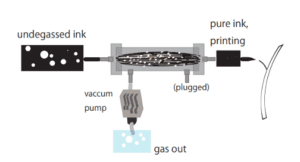
Home Applications Liquid Degassing Ink Degassing
An inkjet printer is a type of printer that uses thin nozzles at the tip ofthe ink head to eject ink onto paper for printing. If air bubbles are introduced when ink is ejected, they can cause printing errors such as misprinting andnozzle clogging during printing. Bubbles are caused by the precipitation of dissolved gases due to repeated pressurization and depressurization of the ink head or heating.
There are several methods for deaerating ink, including vacuum treatment, heating treatment, and ultrasonic treatment. Among these methods, the hollow fiber membrane module, which is a type of vacuumtreatment, is widely used because it does not change the composition ofthe ink and saves space.
Degassing with hollow fiber membrane modules is simple. By flowing ink through the hollowfiber membrane and depressurizing the outside with a vacuum pump, the dissolved gases contained in the ink permeate through the membrane and are continuously removed from the ink. (See figure at bottom).
UV-curable inksoften used in inkjet printers for large-size printers are highly viscous at room temperature, and heating reduces their viscosity. Heating lowers the pressure drop in the membrane module and increases throughput, so thedegassing process can be made more efficient by heating the ink.
NAGASEP’s silicon hollow fiber membrane demonstrates excellent heat resistance of up to200°C and outstanding solvent resistance, making it suitable for ink deaeration modules. The maximum usable temperature depends on the material of the container used. For example, it canreach up to 80°C with polyvinyl chloride, 120°C with polycarbonate, and 200°C with aluminum.
In addition to the internal perfusion modules that allow ink to flow inside the hollow fibers, NAGASEP also offers external perfusion modules that weave the hollow fibers in a gauze-like structure. The external perfusion modules have higher deaeration performance due to improved contact efficiency between the dissolved gases and the membrane. Furthermore, these modules have lower pressure loss compared to the internal perfusion modules, which is another notable feature.
